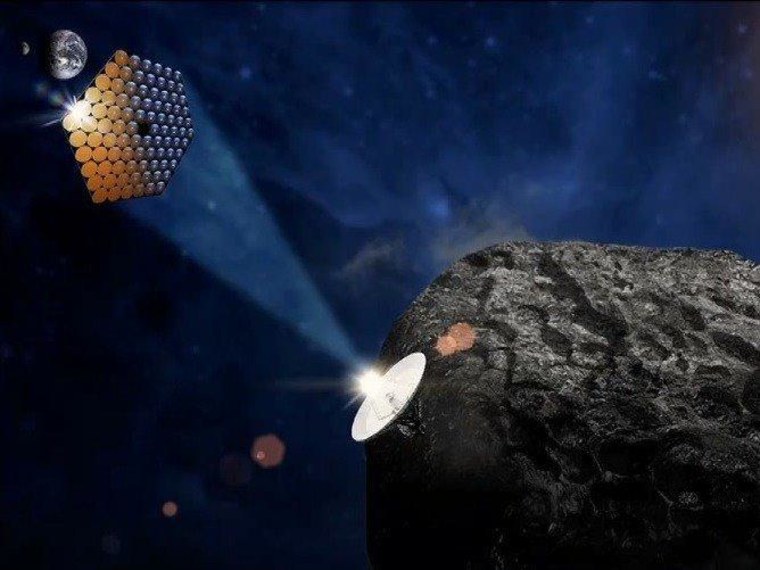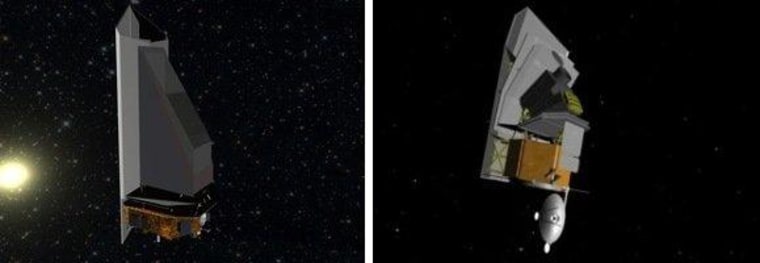
Experts on near-Earth objects wondered whether February's meteor blast over Russia would serve as a wakeup call about asteroids — and two months later, there's ample evidence that it has. But there are two sides to that wakeup call, having to do with potential opportunities as well as potential threats.
Nothing illustrates that better than this week's developments: In Flagstaff, Ariz., researchers are discussing ways to detect, track and head off space rocks that could wreak destruction on Earth. In Pasadena, Calif., NASA's Jet Propulsion Laboratory announced that an infrared sensor for tracking asteroids and comets has passed a critical design test. And in Bellevue, Wash., the Planetary Resources space mining venture says it's partnering with the Bechtel construction company on future efforts to mine asteroids for raw materials.
"Bechtel has a history of consistently tackling the most challenging projects, beginning with the construction of the Hoover Dam more than 75 years ago," Peter Diamandis, the co-founder and co-chairman of Planetary Resources, said in a news release announcing the deal. Today, California-based Bechtel is one of the world's leaders in the engineering, procurement and construction industry. It will join Planetary Resources' billionaire-heavy list of investors — and assist the company in its long-term mission to mine near-Earth asteroids for precious metals and outer-space water.
Diamandis and his fellow co-founder, Eric Anderson, have said asteroid mining could turn into a multitrillion-dollar industry if their vision becomes reality.
"Planetary Resources' mission is ambitious, but they've assembled a world-class team to succeed," Riley Bechtel, the chairman and CEO of Bechtel, said in the news release. "Our companies share a common vision to continually innovate and push boundaries, all aimed at contributing a better quality of life."
Speaking of life, Planetary Resources' president, Chris Lewicki, is among the scores of experts attending this week's Planetary Defense Conference in Flagstaff. "It's always an extremely fun and informative conference, as it focuses entirely on asteroids ... how often do you get to consider defending the Earth from space rocks?" he wrote in a blog posting on Tuesday.
NASA's proposed mission to grab an asteroid and park it near the moon by 2021 has been one of the meeting's major topics, but the gathering also provided the latest information on the threats posed by near-Earth objects, and what to do about them:
- Experts estimate that there are 9 million near-Earth asteroids as large as the 17-meter-wide (55-foot-wide) space rock that broke apart over Russia on Feb. 15, and virtually all of them are too small to track using current observational tools. So far, detection systems have found less than 1 percent of the asteroids smaller than 100 meters (which is big enough to wipe out a city).
- Lewicki passed along word of a scientific study suggesting that even "rubble-pile" asteroids can become more cohesive over time, thanks to the forces that bind together the smallest grains in their size distrbutions.
- Several schemes for fending off dangerous asteroids were presented — including plans to deflect them with impact vehicles, divert them or blast them to smithereens with nuclear bombs, or guide them gently into non-threatening orbits using gravity tractors.
JPL's Shyam Bhaskaran described an "AutoNav" system that could guide an impactor autonomously to hit an asteroid target at speeds of up to 30,000 mph. "It's not that easy," Bhaskaran said in a news release. "Hitting an asteroid with a spacecraft traveling at hypervelocity is like shooting an arrow at a target on a speeding race car."
The conference began on Monday and runs through Friday. Check out the program, feast your eyes on the video coverage (with live streaming as well as archived clips for each session), and follow the action via Twitter with the hashtag #PDC2013.

Infrared eyes
The first step in planetary defense is to find all those potentially threatening asteroids — and during the Flagstaff conference, the spotlight focused on two proposed space telescopes designed to look for space rocks. The B612 Foundation's Sentinel Space Telescope, currently scheduled for launch in 2017 or 2018, would use an infrared sensor to look for Earth-threatening asteroids from a Venus-type orbit. Ball Aerospace reportedly has 25 people working on the Sentinel project, and so far, B612 has raised $2 million of the mission's estimated $450 million cost.
Meanwhile, JPL is working on the components for a future space mission known as NEOCam. Like Sentinel, NEOCam would scan the skies from an outer-space vantage point, looking for the infrared glow of asteroids. The mission is getting technology development funds from NASA's Discovery Program — and on Monday, JPL said NEOCam's infrared sensor passed a design test that assessed its performance under simulated deep-space conditions. A research paper detailing the sensor's design and capabilities is to be published by the Journal of Optical Engineering.
"Infrared sensors are a powerful tool for discovering, cataloging and understanding the asteroid population," JPL researcher Amy Mainzer, a co-author of the paper, said in a news release. "When you observe a space rock with infrared, you are seeing its thermal emissions, which can better define the asteroid's size, as well as tell you something about composition."
Correction for 1:50 p.m. ET April 17: Good news, everyone! The Planetary Defense Conference runs through Friday. The bad news is that I originally wrote Wednesday instead, and that I wrote "#PDC2012" rather than #PDC2013 for the Twitter hashtag. Sorry about that!
More about asteroids:
- Asteroid miners get a boost from NASA
- NASA on asteroid threat: Pay now or pray later
- NBC News archive on asteroids
Alan Boyle is NBCNews.com's science editor. Connect with the Cosmic Log community by "liking" the log's Facebook page, following @b0yle on Twitter and adding the Cosmic Log page to your Google+ presence. To keep up with Cosmic Log as well as NBCNews.com's other stories about science and space, sign up for the Tech & Science newsletter, delivered to your email in-box every weekday. You can also check out "The Case for Pluto," my book about the controversial dwarf planet and the search for new worlds.